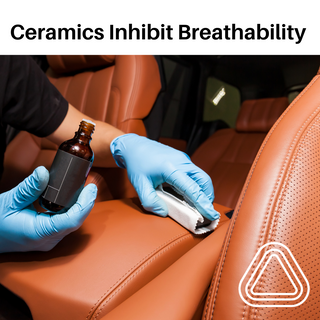Why you should not ceramic coat leather
Ceramic coating has gained popularity in the automotive world for its ability to protect and enhance the appearance of various surfaces, such as paint, glass, and even leather. While it may seem like a great idea to extend this protective layer to your leather car seats, there are many drawbacks that could outweigh the benefits. In this blog post, we'll explore why ceramic coating leather car seats might not be the best idea with the damage it can cause.
Loss of Natural Characteristics:
Leather car seats have a distinct and natural look and feel. Applying a ceramic coating can alter these characteristics by creating a uniform, plastic-like surface. This results in the loss of the leather's original texture and can give the seats an unnatural appearance.
Reduced Breathability:
Leather is a breathable material that allows air to circulate, preventing the buildup of moisture and maintaining a comfortable environment. Ceramic coatings can compromise this breathability by creating a barrier on the leather surface. This may lead to discomfort, especially during hot weather, as the coating inhibits the leather's ability to breathe. With the lack of breathability, this then accelerates damage, increased cracking and increased drying out, leading to stiff hard leather.

Potential for Cracking:
Leather, like any natural material, expands and contracts with temperature changes. Ceramic coatings are rigid and may not flex well with the natural movements of the leather. Over time, this inflexibility will lead to the formation of micro-cracks in the coating, diminishing its protective qualities and compromising the leather beneath. This then leaves the leather open to further damage taking place. If ceramics have been put on leather that’s over 3 years old, then you are creating bigger issues as by then the clear coat has been removed and the leather is even more breathable.
Difficulty in Maintenance:
While ceramic coatings are known for their durability, maintaining them on leather surfaces can be challenging. Leather requires specific care, including regular conditioning to prevent drying and cracking. The ceramic coating may interfere with the absorption of leather conditioners, making it harder to keep the seats in optimal condition. Due to the ceramic coating fully sealing the leather, this accelerates wear and tear and degrades the leather far quicker than normal.
Limited Repair Options:
If the ceramic coating on your leather car seats becomes damaged or starts to show signs of wear, repairing it can be a complex and time-consuming process. Unlike other surfaces, leather is not as easily re-coated like paintwork, and attempting to fix issues that have ceramic coatings on the leathers painted surface will lead to further damage taking place trying to repair the surface that’s been damaged, causing a more costly repair to have to be carried out.
In conclusion, while ceramic coating has proven benefits for certain automotive surfaces, applying it to leather car seats may pose more risks than advantages. The loss of natural characteristics, reduced breathability, risk of cracking, difficulty in maintenance, and limited repair options should be carefully considered before deciding to ceramic coat your leather seats. It's crucial to weigh the aesthetic appeal against the long-term well-being of your car's interior when making such decisions. Always consult with professionals and consider alternative leather protection methods that preserve the natural qualities of this luxurious material.
This video will help you with varying protection options

